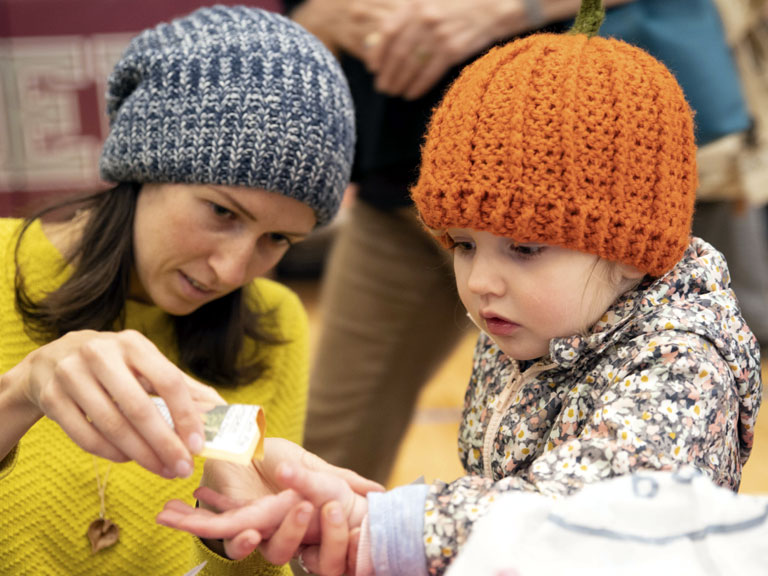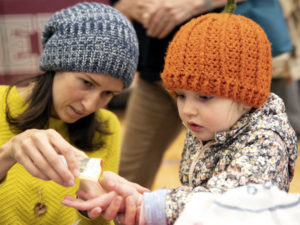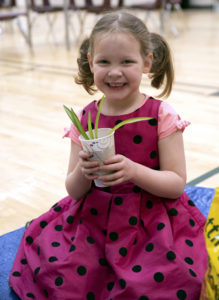County News
Seedy Saturday celebration


(L-R): Volunteer Rebecca Lamb measures out some pumpkin seeds for Fiona Peloso to take home.
Tenth annual event draws hundreds to PECI
Spring may yet be some distance away, but there was definitely a spring in the steps of visitors to the 10th annual Seedy Saturday event in the County as they browsed through the offerings on the seed swap tables or perused the items on sale from the nearly two dozen vendors present. In addition, there were a number of community groups and organizations offering information as well as an area for children to try their hand at potting up a plant cutting to take home. This is the third year the event has been held at PECI, and it has continued to grow in scope and popularity. “We’re really excited,” says Tamara Segal, one of the organizers of the event. “I’ve heard people say, ‘It’s my favourite event of the year,’ and I feel this way too. There’s a real spirit of community. And it happens in late winter when everybody has been hibernating and it feels like everybody is coming out and thinking about gardening, which is exciting.”
This is one of over 160 Seedy Saturday events taking place across Canada in the early months of the year, although they are actually not all held on Saturdays. These events are held under the umbrella of an organization called Seeds of Diversity, which has as one of its aims the objective of preserving the biodiversity of seeds by keeping them in the public domain. “The idea is that everybody will take responsibility for saving the seeds in their own gardens, and then bring them in for exchange,” says Segal. “There’s a concern that some of these variety of seeds that have been sustaining us for generations might get lost, and we want to make sure they get maintained so there’s a large amount of diversity and the population of flora is healthier.”
Saving seeds is as much an art as it is a science, and for small commercial seed vendors it is a very labour-intensive process. Annie Richard is a co-owner of the Kitchen Table Seed House based on Wolfe Island. Her company grows seeds and develops vegetable varieties suitable for growing in the northeastern Canada climate. “We are focused on breeding, selecting and growing varieties of vegetables that we think are very flavourful and that gardeners will like,” she says. “There are quite a few challenges to growing crops for seeds. You have to leave them in the ground longer to actually flower and produce seeds, so it’s more susceptible to weather, pests or diseases. For some biennial vegetables, we have to dig the plants up, store them over the winter and keep them alive to plant again in the spring for the second year for them to grow seeds.”

Aubrey Kelly is all smiles with her plant cutting.
This year there were also two vendors offering worms for indoor composting. Blair Richards-Koeslag grows organic vegetables and teaches permaculture gardening. She started off 12 years ago with a yogurt container filled with worms and now sells bucketfuls derived from her original stock. “It’s a kind of African worm called red wigglers, and they’re special because they have a bacterial digestive system so they colonize all kinds of very beneficial bacteria in the soil they create. They make this wonderful earth,” she says. “You don’t need very much of it. It’s more like a soil additive where you add a little bit in with each plant you’re starting.” A bucketful of worms will happily stay under the kitchen counter and convert vegetable scraps and peelings into a nutrient-dense mix ready to be used for the garden, and because it’s a completely bacterial process, there are no odours associated with anaerobic decomposition.
A small but important part of the Picton Seedy Saturday has been the inclusion of a children’s area. In addition to giving parents a little room to take a break from the sometimes hectic main floor, it is an opportunity to cultivate a bit of a green thumb in the little ones. This year the kids could take home an easy-to-care-for plant cutting, but it is also a means of sowing the seeds of gardening in the next generation. “They need to know about saving seeds and to understand the importance of biodiversity,” says Segal. “If they don’t know about this, then it can all be lost, so this is actually the most important thing.”

Comments (0)